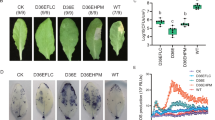Abstract
IN a previous communication1 the nematode Ditylenchus destructor Thorne, 1945, was recorded from the roots of a number of plants commonly found on Prince Edward Island. Two of these plants, Trifolium pratense L. and T. hybridum L., are abundant in most grass fields on the Island. Further examinations of roots of these two species from fields infested with D. destructor showed that there were considerable numbers of the nematode in the rhizospheres (the soil adhering to the roots after they have been dug and gently shaken) and some within mature roots of these plants but very few in or about young roots. Adults and larvæ were both present in the rhizospheres of plants taken from a frozen field in February, suggesting that there may be no special overwintering stage of the nematode such as is found in D. dipsaci.
This is a preview of subscription content, access via your institution
Access options
Subscribe to this journal
Receive 51 print issues and online access
$199.00 per year
only $3.90 per issue
Buy this article
- Purchase on Springer Link
- Instant access to full article PDF
Prices may be subject to local taxes which are calculated during checkout
Similar content being viewed by others
References
Henderson, V. E., Nature, 167, 952 (1951).
Baker, A. D., Brown, G. L., and James, A. B., Science, 119, 92 (1954).
Fezer, K. D., Dissert. Abst. 17, 939 (1957).
Author information
Authors and Affiliations
Rights and permissions
About this article
Cite this article
HENDERSON, V. Relationship between Some Clovers and Ditylenchus destructor Thorne, 1945. Nature 181, 59–60 (1958). https://doi.org/10.1038/181059a0
Issue Date:
DOI: https://doi.org/10.1038/181059a0
Comments
By submitting a comment you agree to abide by our Terms and Community Guidelines. If you find something abusive or that does not comply with our terms or guidelines please flag it as inappropriate.



